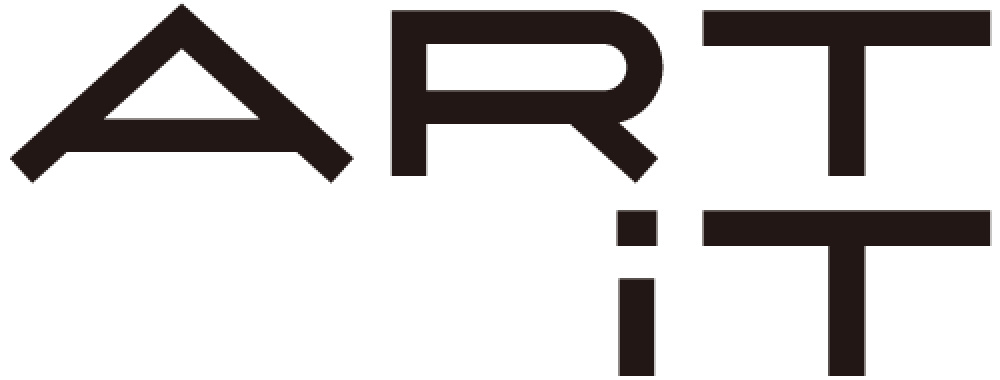Sophie Calle, For the Last and First Time
Press Conference at the Hara Museum of Contemporary Art
(16:30/March 19, 2013 / The Hall at the Hara Museum)
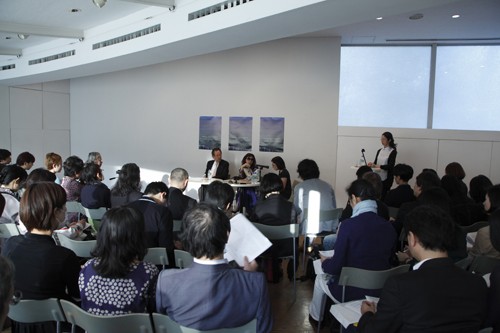
About The Last Image (2010)
While residing and doing research in Istanbul, I learned that it was called the “city of the blind” when it was Byzantium. Before settlers came to the more beautiful, fertile side (of the Bosporus) where Byzantium was established, they chose to live on the other uglier side of the strait. They were thus “blind” to the other better side, whence came this story. I’m not sure if it’s true, but it has been handed down as a myth.
*1 For The Last and First Time appeared in 2011 at the Sakıp Sabancı Museum as a solo exhibition connected with the 12th Istanbul Biennial.
I once made a work called Blind (1986) in which I asked people who were born without sight to define beauty. During that project, I met many people who had lost their sight after birth, but I didn’t interview them because they didn’t fit that particular project. I regretted that and wanted to do another project with them as the subject. But because I don’t like to repeat myself and was pressed with other projects, I didn’t start making it immediately.
So when I heard the story about the “city of the blind,” I thought a project about blind people would be perfect. I went to schools for the blind, NPOs and universities to do interviews. The question that I put to them might seem cruel to sighted people, but since blindness is a part of their normal lives, they didn’t make a big thing about it and spoke with me willingly.
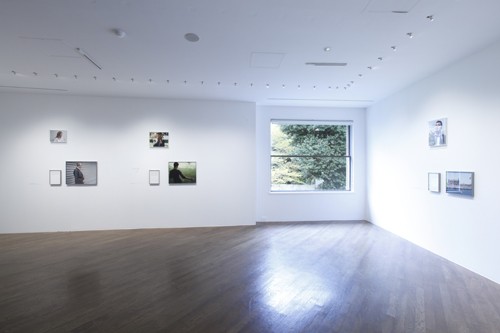
The Last Image (2010) © ADAGP, Paris 2013
For each interview, I produced a photographic interpretation based on the description given by the interviewee. For example, if a certain thing was mentioned, a chair or a bedside lamp for instance, I went to their home to take a picture of that thing. If a gun or a car was involved in their accident, I reproduced the incident as they described it. If a city clock tower was included, I went to the town to snap the tower. If a husband was involved, I took a picture of the husband. I tried to make the image as true to the story as possible.
There was only one exception, and that was the person in the first photo. He was someone who was born without sight. When I first went to a school for the blind (in Istanbul) to recruit participants, he insisted on taking part in the project. I told him that he wasn’t right for the project, but he was persistent, so I made the piece in question based on his description of a dream.
About Voir la mer (2011)
I made this work around the same time as The Last Image. It was my third month of living in Istanbul when I had some newspaper articles translated for me. There was a piece about people who have never seen the sea. They were written up as a poor class of people (mainly from the hinterland) who had never seen the ocean even though Istanbul is surrounded by water. It was like they were an entire social strata that was excluded from society. I went with a social worker to where they lived and over two days took 14 of them to view the sea for the first time. (*2)
*2 “I didn’t take them to some distant sea, nor did I ask them to get on a boat. Instead, I took them somewhere not even 10 km away from their homes. I wanted them to enter a wide new world that was near to them.” (Quoted from a conversation with Sophie during her stay Japan.)
I thought about how to shoot the event. There would be no second chance if I failed the first time. I therefore brought along a director, Caroline Champetier. For the camera position, I first thought of positioning the camera between the viewing person and the sea. But I gave up on that idea because, first of all, they would be looking at the camera and not the sea, and also I didn’t want it to end up like some TV documentary that was merely depicting their lives.
The first person I filmed was the woman holding a baby. I was using two cameras at the time, one in back and one to the side. The video I used was the one taken from the back. When I stood to her side, she ended up talking a bit too much about what she was feeling, which was not what I wanted. She spoke all the while as she looked at the sea and the camera intruded too much into her private space. I felt my presence was destroying any feeling of intimacy that she was having with the sea, which wasn’t a good thing.
I felt the back of the person says a lot. Also, from that position, it would be possible to look at the sea along with the person. That’s why I decided to place the camera at their backs. After they had viewed the sea, I had them look back towards me with the same gaze.
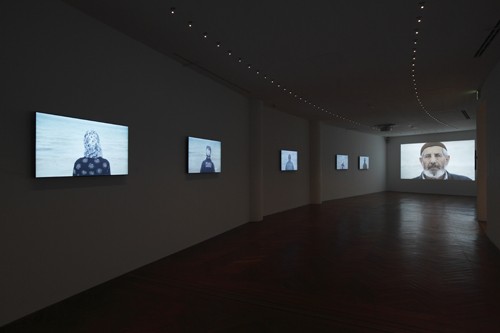
Voir la mer (2011) ©ADAGP, Paris 2013
[Q & A]
Q: My question is about The Last Image. How long was your interview with each person? Depending on the person, I would think some had stronger impressions of something other than the last thing they saw. Why did you choose to ask about the last thing?
A: What I was interested in was the last time. It is impossible for anyone to know when they will experience something for the last time. Exactly what is the last time? There is something poetic about it. It’s also possible that what they were describing wasn’t actually the last time. Perhaps it was something that interested them. They spoke, I photographed. When it happened was not that important. I wasn’t conducting a sociological study to determine representative cases. My idea was if somehow the text and the photographs came together as a work of art, I would be happy.
There is one person with two portraits. He was someone I spent an entire day with. At first I was thinking of making a different kind of image. Since I wasn’t familiar with Istanbul, I thought I would have a blind person guide me around the city. But when I did, that person began boasting about how he was able to get around the city by himself. In the end it didn’t so work out so well because I didn’t understand Turkish. So I substituted him with different person and ended up making the photographs that I did. With some people, I spent several hours. With others, it was as short as 10 minutes. It all depended on the person.
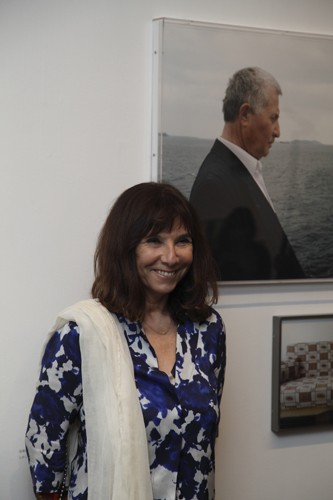
Sophie at the exhibition
Q: The Last Image is a very concrete work. Voir la mer, on the other hand, has a primitive kind of heaviness about it. I wanted to know if this contrast was conscious on your part.
A: No, it was not my plan to combine the concrete with the abstract. What I combined were the first time and the last time, as the title says. It’s like a party. I like the beginning and the end, but not so much the middle.
Q: My question is about Voir la mer. These were people who had never seen the sea, but had they ever seen the ocean in some other form, like in a photo?
A: I would think most like they had. But the feeling that they got from the real thing was entirely different. There was one video of children. What I saw was a reaction that was, I feel, not the same as if they were seeing it on TV. Without thinking, they pulled up their pants legs or skirts as they entered the water, but they didn’t take their shoes off. I thought that contrast was interesting.
Q: Did the people in Voir la mer have a desire to see the sea? Or were they just interested in being part of an art project?
A: I don’t think they were interested in being part of an art project. Such a thing is very far from their everyday lives. However, the idea of taking a day off and going to the sea was attractive to them.
Q: Did those people have a desire to see the ocean? Did they have a longing for that?
A: I don’t know the local language, so I don’t know what the truth of the matter is. A work of art is not a sociological study. They thought it would be great to see the sea, I had an idea for a work of art, and the two came together. It was not my aim to spend several days with them in order to gain a better understanding of their lives. In the middle of the project, I was joined by someone who spoke Kurdish, but not Turkish. I never had a translator who could help me converse with them, so conversations ended up being quite limited.
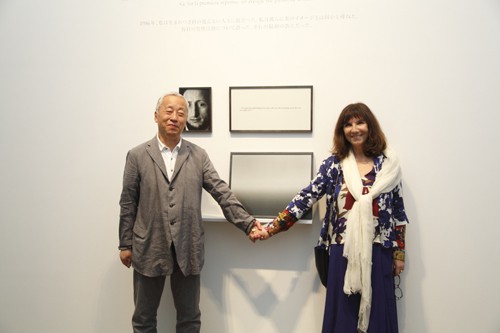
Hiroshi Sugimoto and Sophie.
After the press conference, an opening reception was held for Hara Museum members and other related guests who were given a preview of the exhibition.
This is a shot taken at reception. It is one piece from the well-known series by Sophie called Blind (1986). As a special collaborative work made in 1999, it is a single work from the series that was combined with a photograph from Hiroshi Sugimoto’s Seascape series. It is a precious photo of the two artists joining hands in front of that work.
The guests enjoyed Laurent-Perrier champagne provided by Suntory Wine International and cakes created in the spirit of the artist by Pierre Hermé Paris during this congenial launching of the exhibition.
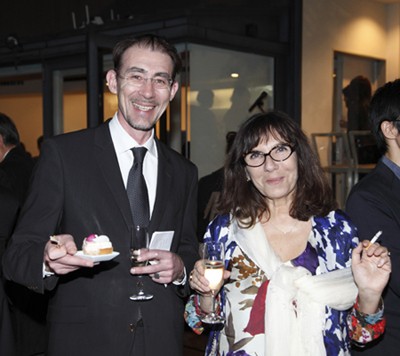
Mr. Bertrand Fort, Cultural Counsellor at the French Embassy and Sophie
Photos: Keizo Kioku
